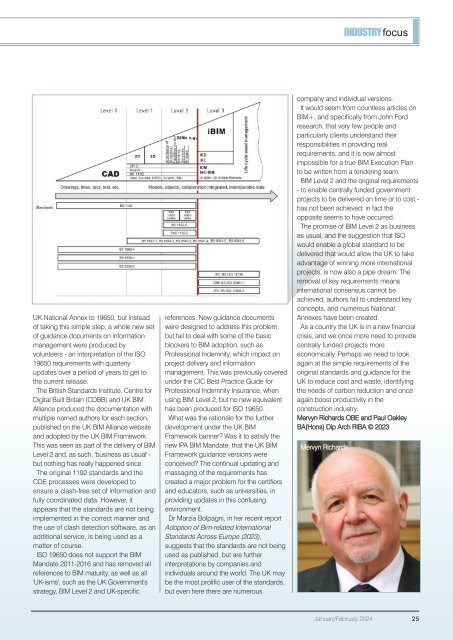CU4201
Create successful ePaper yourself
Turn your PDF publications into a flip-book with our unique Google optimized e-Paper software.
INDUSTRYfocus<br />
UK National Annex to 19650, but instead<br />
of taking this simple step, a whole new set<br />
of guidance documents on information<br />
management were produced by<br />
volunteers - an interpretation of the ISO<br />
19650 requirements with quarterly<br />
updates over a period of years to get to<br />
the current release.<br />
The British Standards Institute, Centre for<br />
Digital Built Britain (CDBB) and UK BIM<br />
Alliance produced the documentation with<br />
multiple named authors for each section,<br />
published on the UK BIM Alliance website<br />
and adopted by the UK BIM Framework.<br />
This was seen as part of the delivery of BIM<br />
Level 2 and, as such, 'business as usual' -<br />
but nothing has really happened since.<br />
The original 1192 standards and the<br />
CDE processes were developed to<br />
ensure a clash-free set of information and<br />
fully coordinated data. However, it<br />
appears that the standards are not being<br />
implemented in the correct manner and<br />
the use of clash detection software, as an<br />
additional service, is being used as a<br />
matter of course.<br />
ISO 19650 does not support the BIM<br />
Mandate 2011-2016 and has removed all<br />
references to BIM maturity, as well as all<br />
'UK-isms', such as the UK Government's<br />
strategy, BIM Level 2 and UK-specific<br />
references. New guidance documents<br />
were designed to address this problem,<br />
but fail to deal with some of the basic<br />
blockers to BIM adoption, such as<br />
Professional Indemnity, which impact on<br />
project delivery and information<br />
management. This was previously covered<br />
under the CIC Best Practice Guide for<br />
Professional Indemnity Insurance, when<br />
using BIM Level 2, but no new equivalent<br />
has been produced for ISO 19650.<br />
What was the rationale for the further<br />
development under the UK BIM<br />
Framework banner? Was it to satisfy the<br />
new IPA BIM Mandate, that the UK BIM<br />
Framework guidance versions were<br />
conceived? The continual updating and<br />
massaging of the requirements has<br />
created a major problem for the certifiers<br />
and educators, such as universities, in<br />
providing updates in this confusing<br />
environment.<br />
Dr Marzia Bolpagni, in her recent report<br />
Adoption of Bim-related International<br />
Standards Across Europe (2023),<br />
suggests that the standards are not being<br />
used as published, but are further<br />
interpretations by companies and<br />
individuals around the world. The UK may<br />
be the most prolific user of the standards,<br />
but even here there are numerous<br />
company and individual versions.<br />
It would seem from countless articles on<br />
BIM+, and specifically from John Ford<br />
research, that very few people and<br />
particularly clients understand their<br />
responsibilities in providing real<br />
requirements, and it is now almost<br />
impossible for a true BIM Execution Plan<br />
to be written from a tendering team.<br />
BIM Level 2 and the original requirements<br />
- to enable centrally funded government<br />
projects to be delivered on time or to cost -<br />
has not been achieved; in fact the<br />
opposite seems to have occurred.<br />
The promise of BIM Level 2 as business<br />
as usual, and the suggestion that ISO<br />
would enable a global standard to be<br />
delivered that would allow the UK to take<br />
advantage of winning more international<br />
projects, is now also a pipe dream. The<br />
removal of key requirements means<br />
international consensus cannot be<br />
achieved, authors fail to understand key<br />
concepts, and numerous National<br />
Annexes have been created.<br />
As a country the UK is in a new financial<br />
crisis, and we once more need to provide<br />
centrally funded projects more<br />
economically. Perhaps we need to look<br />
again at the simple requirements of the<br />
original standards and guidance for the<br />
UK to reduce cost and waste, identifying<br />
the needs of carbon reduction and once<br />
again boost productivity in the<br />
construction industry.<br />
Mervyn Richards OBE and Paul Oakley<br />
BA(Hons) Dip Arch RIBA © 2023<br />
Mervyn Richards<br />
January/February 2024 25
















